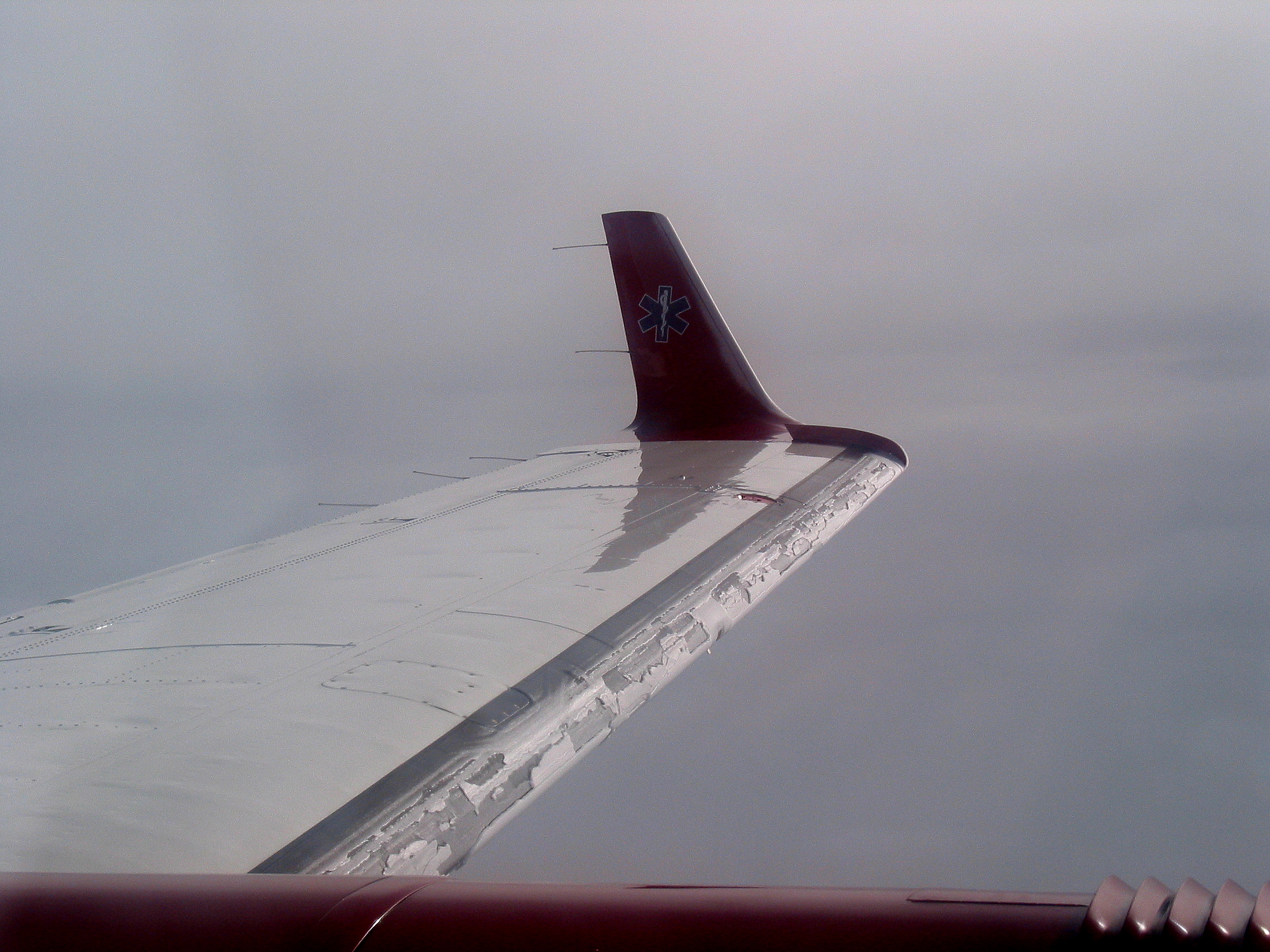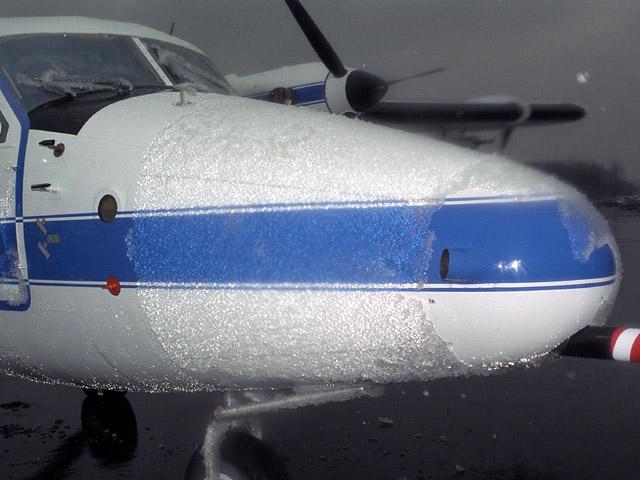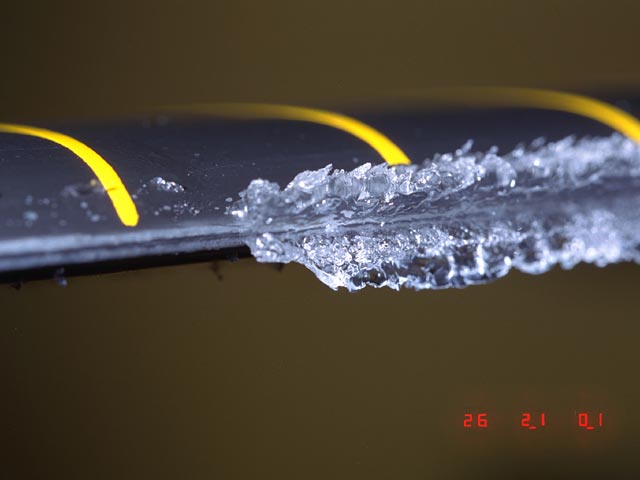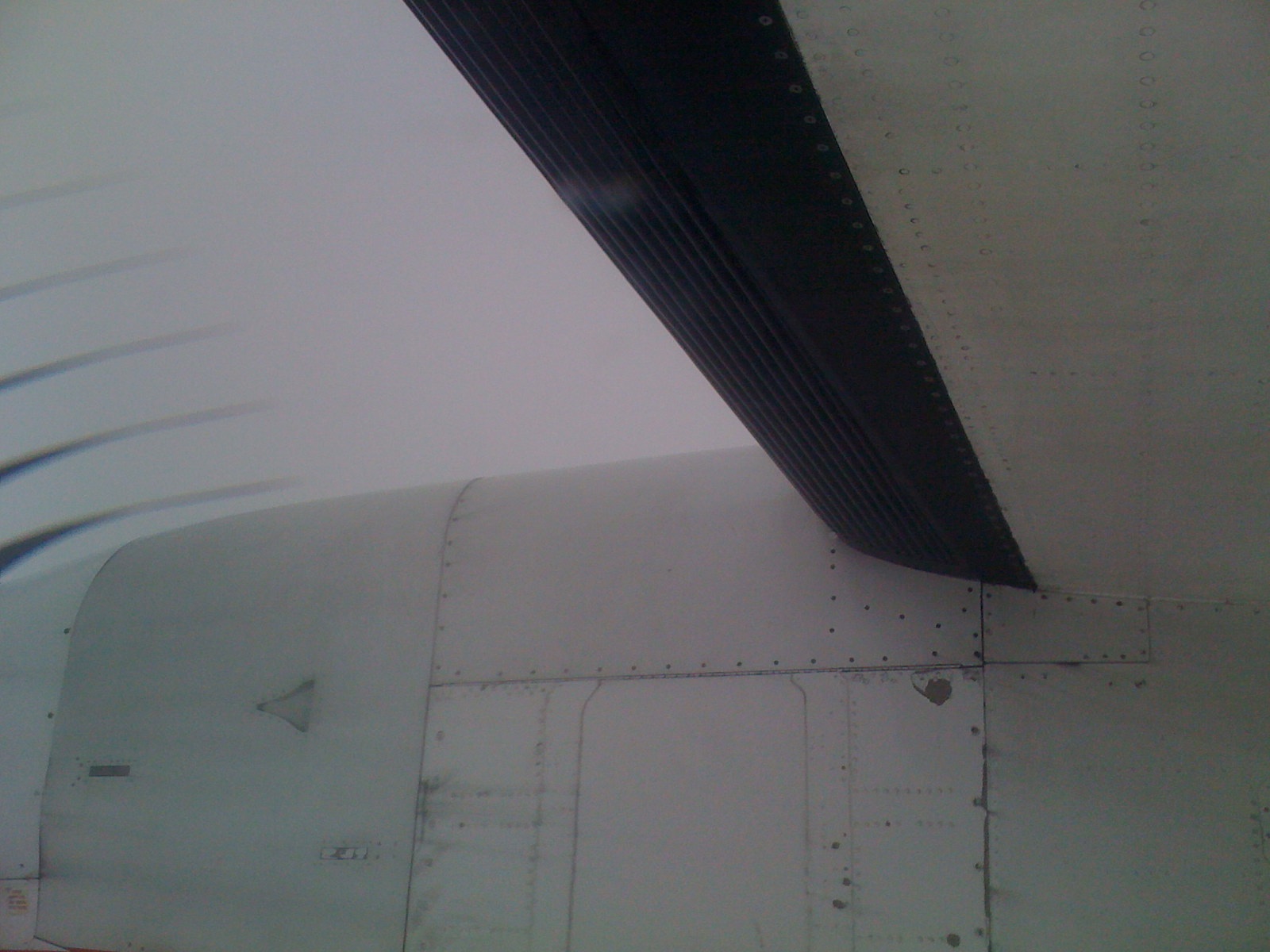Icing Conditions on:
[Wikipedia]
[Google]
[Amazon]
 In
In
 *
*
 The wing will ordinarily stall at a lower angle of attack, and thus a higher airspeed, when contaminated with ice . Even small amounts of ice will have an effect, and if the ice is rough, it can be a large effect nonetheless. Thus an increase in approach speed is advisable if ice remains on the wings. How much of an increase depends on both the aircraft type and amount of ice. Stall characteristics of an aircraft with ice-contaminated wings will be degraded, and serious roll control problems are not unusual. The ice accretion may be asymmetric between the two wings which requires calibrating. Also, the outer part of a wing, which is ordinarily thinner and thus a better collector of ice, may stall first rather than last.
The wing will ordinarily stall at a lower angle of attack, and thus a higher airspeed, when contaminated with ice . Even small amounts of ice will have an effect, and if the ice is rough, it can be a large effect nonetheless. Thus an increase in approach speed is advisable if ice remains on the wings. How much of an increase depends on both the aircraft type and amount of ice. Stall characteristics of an aircraft with ice-contaminated wings will be degraded, and serious roll control problems are not unusual. The ice accretion may be asymmetric between the two wings which requires calibrating. Also, the outer part of a wing, which is ordinarily thinner and thus a better collector of ice, may stall first rather than last.
 To protect an aircraft against icing in-flight, various forms of anti-icing or deicing are used:
* A common approach is to route engine "bleed air" into ducting along the leading edges of wings and tailplanes. The air heats the leading edge of the surface and this melts or evaporates ice on contact. On a turbine powered aircraft, air is extracted from the compressor section of the engine. If the aircraft is turbocharged piston powered, bleed air can be scavenged from the turbocharger.
* Some aircraft are equipped with pneumatic
To protect an aircraft against icing in-flight, various forms of anti-icing or deicing are used:
* A common approach is to route engine "bleed air" into ducting along the leading edges of wings and tailplanes. The air heats the leading edge of the surface and this melts or evaporates ice on contact. On a turbine powered aircraft, air is extracted from the compressor section of the engine. If the aircraft is turbocharged piston powered, bleed air can be scavenged from the turbocharger.
* Some aircraft are equipped with pneumatic
Aircraft Icing – NASA Page
14 CFR 25 Appendix C – Atmospheric Icing Conditions for Aircraft Certification
Weather hazards to aircraft Ice in transportation Frost and rime
 In
In aviation
Aviation includes the activities surrounding mechanical flight and the aircraft industry. ''Aircraft'' includes fixed-wing and rotary-wing types, morphable wings, wing-less lifting bodies, as well as lighter-than-air craft such as hot a ...
, icing conditions are atmospheric conditions that can lead to the formation of water ice on an aircraft. Ice accretion and accumulation can affect the external surfaces of an aircraft – in which case it is referred to as ''airframe icing'' – or the engine
An engine or motor is a machine designed to convert one or more forms of energy into mechanical energy.
Available energy sources include potential energy (e.g. energy of the Earth's gravitational field as exploited in hydroelectric power ...
, resulting in carburetor icing
Carburetor icing, or carb icing, is an icing condition which can affect any carburetor under certain atmospheric conditions. The problem is most notable in certain realms of aviation.
Carburetor icing is caused by the temperature drop in the ca ...
, air inlet icing or more generically ''engine icing''. These phenomena may possibly but do not necessarily occur together. Both airframe and engine icing have resulted in numerous fatal accidents in aviation history.
Not all aircraft, especially general aviation
General aviation (GA) is defined by the International Civil Aviation Organization (ICAO) as all civil aviation aircraft operations with the exception of commercial air transport or aerial work, which is defined as specialized aviation services ...
aircraft, are certified for ''flight into known icing'' (FIKI) – that is flying into areas with icing conditions certain or likely to exist, based on pilot report
A pilot report or PIREP is a report of actual flight or ground conditions encountered by an aircraft. Reports commonly include information about atmospheric conditions (like temperature, icing, turbulence) or airport conditions (like runway con ...
s, observations
Observation is the active acquisition of information from a primary source. In living beings, observation employs the senses. In science, observation can also involve the perception and recording of data via the use of scientific instrument ...
, and forecasts
Forecasting is the process of making predictions based on past and present data. Later these can be compared (resolved) against what happens. For example, a company might estimate their revenue in the next year, then compare it against the actual ...
. In order to be FIKI-certified, aircraft must be fitted with suitable ice protection system
In aeronautics, ice protection systems keep atmospheric moisture from accumulating on aircraft surfaces, such as wings, propellers, rotor blades, engine intakes, and environmental control intakes. Ice buildup can change the shape of airfoils ...
s to prevent accidents by icing.
Definition
Icing conditions exist when the air contains droplets of supercooled liquid water. They freeze on contact with a potential nucleation site, which in this case is the parts of the aircraft, causing icing. Icing conditions are characterized quantitatively by the average droplet size, the liquid water content and the air temperature. These parameters affect the extent, type and speed that characterize the formation of ice on an aircraft.Federal Aviation Regulations
The Federal Aviation Regulations (FARs) are rules prescribed by the Federal Aviation Administration (FAA) governing all aviation activities in the United States. The FARs comprise Title 14 of the Code of Federal Regulations (CFR). A wide variety ...
contain a definition of icing conditions that some aircraft are certified to fly into. So-called SLD, or supercooled large droplet, conditions are those that exceed that specification and represent a particular hazard to aircraft, which all aircraft must try to avoid.
Qualitatively, pilot report
A pilot report or PIREP is a report of actual flight or ground conditions encountered by an aircraft. Reports commonly include information about atmospheric conditions (like temperature, icing, turbulence) or airport conditions (like runway con ...
s indicate icing conditions in terms of their effect upon the aircraft, and will be dependent upon the preexisting capabilities of the aircraft. Different aircraft may report the same quantitative conditions as different levels of icing as a result. Ice detectors are often used to indicate the presence of icing conditions.
Types of structural ice
 *
*Clear ice
Clear ice refers to a solid precipitation which forms when air temperature is between and and there are supercooled, relatively large drops of water (from freezing fog). A rapid accretion and a slow dissipation of latent heat of fusion favor the ...
is often clear and smooth. Supercooled water droplets, or freezing rain
Freezing rain is rain maintained at temperatures below freezing by the ambient air mass that causes freezing on contact with surfaces. Unlike a mixture of rain and snow or ice pellets, freezing rain is made entirely of liquid droplets. The rain ...
, strike a surface but do not freeze instantly. Often "horns" or protrusions are formed and project into the airflow, which smoothens it out. This form of ice is also called glaze.
*Rime ice
Rime ice forms when supercooled water liquid droplets freeze onto surfaces. Meteorologists distinguish between three basic types of ice forming on vertical and horizontal surfaces by deposition of supercooled water droplets. There are also interm ...
is rough and opaque, formed by supercooled drops rapidly freezing on impact. Forming mostly along an airfoil's stagnation point
In fluid dynamics, a stagnation point is a point in a flow field where the local velocity of the fluid is zero.Clancy, L.J. (1975), ''Aerodynamics'', Pitman Publishing Limited, London. A plentiful, albeit surprising, example of such points seem ...
, it generally conforms to the shape of the airfoil.
*Mixed ice is a combination of clear and rime ice, having both properties.
* Frost ice is the result of water freezing on unprotected surfaces while the aircraft is stationary, before flight even starts. This can be dangerous when flight is attempted because it disrupts an airfoil's boundary layer airflow causing a premature aerodynamic stall and, in some cases, dramatically increased drag making takeoff dangerous or impossible, which could lead to accidents prematurely.
*SLD ice refers to ice formed in supercooled large droplet (SLD) conditions. It is similar to clear ice, but because droplet size is large, it extends to unprotected parts of the aircraft and forms larger ice shapes, faster than normal icing conditions, which nearly all aircraft isn't sufficiently protected from. This was a factor in the crash of American Eagle Flight 4184
American Eagle Flight 4184, officially operating as Simmons Airlines Flight 4184, was a scheduled domestic passenger flight from Indianapolis, Indiana to Chicago, Illinois, United States. On , 1994, the performing this route flew into severe ...
.
Effect
 The wing will ordinarily stall at a lower angle of attack, and thus a higher airspeed, when contaminated with ice . Even small amounts of ice will have an effect, and if the ice is rough, it can be a large effect nonetheless. Thus an increase in approach speed is advisable if ice remains on the wings. How much of an increase depends on both the aircraft type and amount of ice. Stall characteristics of an aircraft with ice-contaminated wings will be degraded, and serious roll control problems are not unusual. The ice accretion may be asymmetric between the two wings which requires calibrating. Also, the outer part of a wing, which is ordinarily thinner and thus a better collector of ice, may stall first rather than last.
The wing will ordinarily stall at a lower angle of attack, and thus a higher airspeed, when contaminated with ice . Even small amounts of ice will have an effect, and if the ice is rough, it can be a large effect nonetheless. Thus an increase in approach speed is advisable if ice remains on the wings. How much of an increase depends on both the aircraft type and amount of ice. Stall characteristics of an aircraft with ice-contaminated wings will be degraded, and serious roll control problems are not unusual. The ice accretion may be asymmetric between the two wings which requires calibrating. Also, the outer part of a wing, which is ordinarily thinner and thus a better collector of ice, may stall first rather than last.
Icing prevention and removal
Several methods exist to reduce the dangers of icing, using ice protection systems. The first, and simplest, is to avoid icing conditions altogether, but for many flights this is not practical. If ice (or other contaminants) are present on an aircraft prior to takeoff, they must be removed from critical surfaces. Removal can take many forms: * Mechanical means, which may be as simple as using a broom or brush to remove snow * Application ofdeicing fluid Ground deicing of aircraft is commonly performed in both commercial and general aviation. The fluids used in this operation are called ''deicing'' or ''anti-icing'' fluids. The initials ADF (Aircraft Deicing Fluid), ADAF (Aircraft Deicer and Anti-i ...
or even hot water to remove ice, snow, etc.
* Use of infrared heating to melt and remove contaminants
* Putting the aircraft into a heated hangar until snow and ice have melted
* Positioning aircraft towards the Sun to maximize heating up of snow and ice covered surfaces. In practice this method is limited to thin contamination, by the time and weather conditions.
All of these methods remove existing contamination, but provide no practical protection in icing conditions. If icing conditions exist, or are expected before takeoff, then anti-icing fluids are used. These are thicker than deicing fluids and resist the effects of snow and rain for some time. They are intended to shear off the aircraft during takeoff and provide no inflight protection.
deicing boot
A deicing boot is a type of ice protection system installed on aircraft surfaces to permit a mechanical deicing in flight. Such boots are generally installed on the leading edges of wings and control surfaces (e.g. horizontal and vertical st ...
s that disperse ice build-up on the surface. These systems require less engine bleed air but are usually less effective than a heated surface.
* A few aircraft use a weeping wing
In aeronautics, ice protection systems keep atmospheric moisture from accumulating on aircraft surfaces, such as wings, propellers, rotor blades, engine intakes, and environmental control intakes. Ice buildup can change the shape of airfoils a ...
system, which has hundreds of small holes in the leading edges and releases anti-icing fluid on demand to prevent the buildup of ice.
* Electrical heating is also used to protect aircraft and components (including propellers) against icing. The heating may be applied continuously (usually on small, critical, components, such as pitot static
A pitot-static system is a system of pressure-sensitive instruments that is most often used in aviation to determine an aircraft's airspeed, Mach number, altitude, and altitude trend. A pitot-static system generally consists of a pitot tube, a s ...
sensors and angle of attack vanes) or intermittently, giving an effect similar to the use of deicing boot
A deicing boot is a type of ice protection system installed on aircraft surfaces to permit a mechanical deicing in flight. Such boots are generally installed on the leading edges of wings and control surfaces (e.g. horizontal and vertical st ...
s.
In all these cases, usually only critical aircraft surfaces and components are protected. In particular, only the leading edge of a wing is usually protected.
Carburetor heat
Carburetor, carburettor, carburator, carburettor heat (usually abbreviated to 'carb heat') is a system used in automobile and piston-powered light aircraft engines to prevent or clear carburetor icing. It consists of a moveable flap which draws h ...
is applied to carbureted engines to prevent and clear icing. Fuel-injected engines are not susceptible to carburetor icing, but can suffer from blocked inlets. In these engines, an alternate air source is often available.
There is a difference between deicing and anti-icing. Deicing refers to the removal of ice from the airframe; anti-icing refers to the prevention of ice accumulating on the airframe.
Icing on unmanned aircraft
Unmanned aircraft
An unmanned aerial vehicle (UAV), commonly known as a drone, is an aircraft without any human pilot, crew, or passengers on board. UAVs are a component of an unmanned aircraft system (UAS), which includes adding a ground-based controller ...
are an emerging technology with a large variety of commercial and military applications. In-flight icing occurs during flight in supercooled clouds or freezing precipitation and is a potential hazard to all aircraft. In-flight icing on UAVs imposes a major limitation on the operational envelope.
Unmanned aircraft are more sensitive and susceptible to icing compared to manned aircraft. The main differences between UAVs and manned aircraft when it comes to icing are:
* Size and weight: Small aircraft accumulate ice faster, and more ice per unit area, compared to large aircraft. UAVs are typically smaller than manned aircraft and therefore more sensitive to icing. Furthermore, the added mass from ice accretions can have quick negative effects on UAVs with stringent weight restrictions.
* Flight velocity: High airspeeds lead to heating on the wings or propellers of the aircraft, which can counteract icing to some degree. UAVs fly at lower velocities than manned aircraft and will not benefit from the same heating effect. Therefore, icing on UAVs can occur at a broader range of temperatures than on manned aircraft.
* Laminar flow: The Reynolds number for UAVs is approximately an order of magnitude lower than that for manned aircraft. This leads to UAVs operating in flow regimes where laminar flow effects are more prevalent than turbulent flow effects. Because laminar flow is more easily disturbed than turbulent flow, the negative effects of icing are bigger.
* Type: Rotary-wing UAVs are typically more sensitive to icing than fixed-wing UAVs.
The parts of the UAV most exposed to icing are the airspeed sensor, the leading edge of aerodynamic surfaces, rotors, and propellers.
Icing on UAVs is a global phenomenon, and icing conditions at the operational altitude can occur year round around the world. However, icing risks are particularly big in the sub arctics, Arctic and Antarctic. In large parts of the Nordics, for example, icing conditions are present from 35% to more than 80% of the time from September through May.
Accidents involving icing conditions
References
External links
{{Spoken Wikipedia, En-IcingConditions-article.ogg, date=2017-12-09Aircraft Icing – NASA Page
14 CFR 25 Appendix C – Atmospheric Icing Conditions for Aircraft Certification
Weather hazards to aircraft Ice in transportation Frost and rime